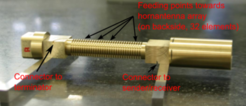Highlights 2012
Research news from the division Plasma Edge and Wall
Micro turbulences in fusion plasmas
IPP physicist chosen as head of a Helmholtz junior scientists group
The IPP physicist Dr. Rachael McDermott is one of 14 junior scientists which have been chosen by the Helmholtz Association in a multi-stage competition from 244 candidates as leader of a Helmholtz Young Investigators Group. Now she can build up her own research group at IPP and will get an annual support of 250,000 Euro for five years.
Rachael McDermott’s research subject is micro turbulences in fusion plasmas. In the hot plasma – the fuel of future fusion power plants – the mini whirls have great influence on the achievable heat insulation. Therefore a fundamental knowledge of the plasma turbulence is very important on the way to a power plant. It is especially interesting to know how the little whirls influence the movement of impurities in the plasma or the rotation of the plasma as a whole. Because this rotation can, under certain circumstances, stabilize the turbulence locally or even build up barriers for the energy and particle loss from the plasma.
In order to be able to understand and control the turbulence, Rachael McDermott’s team, which consists of five people, will investigate the plasma under different experimental conditions. The procedures used for this were specially developed to measure plasma rotation as well as temperature and density of the different kinds of impurities. For the particularly difficult determination of the impurity density – with the aid of neutral particles which are injected into the plasma – close collaboration with a team of specialists from the University of Augsburg is intended. This is because the program is not only to support talented junior scientists but also to reinforce the networking between the Helmholtz centers and partner universities. Rachael McDermott, for instance, does research work at IPP and will have the possibility to hold lectures at the University of Augsburg.
Including this year’s – already tenth – selection round the Helmholtz Association has so far made 164 junior research groups possible. One half of the costs are covered by the home institute and the associated university. The other half is covered by the Initiative and Networking Fund of the Helmholtz Association, to which the IPP is associated.
New "Helmholtz Virtual Institute" entitled "Plasma Dynamical Processes and Turbulence Studies using Advanced Microwave Diagnostics" approved
The Virtual Institute (VI) is positioned strategically centrally between basic research in the field of plasma dynamics with relevance for a wide range of topics, specific research on turbulence in fusion plasmas, as well as the development of new kinds of microwave diagnostics for such investigations, which will also feature inherent advantages in the application in future fusion devices. With partners from various disciplines – universities and research institutes – the VI forms an internationally outstanding competence centre for microwave technology, its application as a diagnostic, and for the interpretation of the data with respect to plasma turbulence.
Plasma dynamical processes do not only play a central role in fusion, but also in extraterrestrial and astrophysical research. Experimental investigations of theoretical models, which can be performed in high temperature plasmas of existing fusion experiments, will be intensified by the VI. Central questions of fusion research, like the turbulent transport and transport barriers, will thereby be investigated. For the development of the appropriate microwave diagnostics the VI includes university institutes with a focus on electro-technical engineering. The expertise for the application of components and for the evaluation and interpretation of the acquired data is provided by the national and international partners participating in the VI. Based on their good functionality under high radiation levels the diagnostics developed within the VI will be among the important diagnostic possibilities for the observation and control of thermonuclear plasmas in future fusion experiments.
The VI will be funded for 4 to 5 years and led by E2M. The partners are Forschungszentrum Jülich, the Institut für Plasmaforschung of the University of Stuttgart, the Institute for High-Frequency Engineering of TU München, LPP Ecole Polytechnique, France, and Ecole Polytechnique Fédérale de Lausanne, Switzerland.

